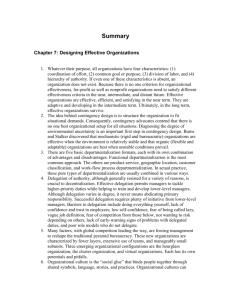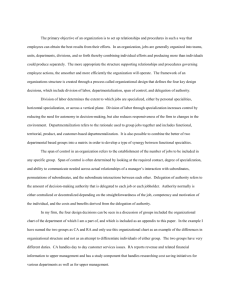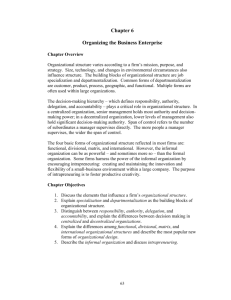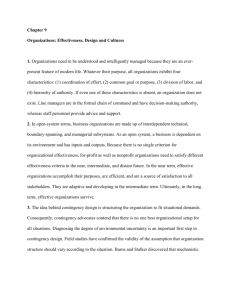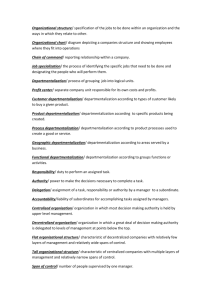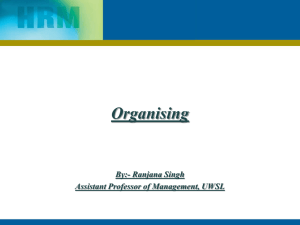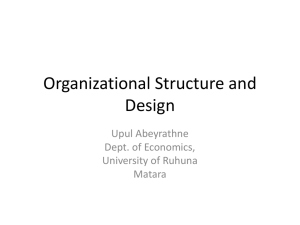10831,"divisional structure with departmentalization by product",3,20,"2000-12-16 00:00:00",40,http://www.123helpme.com/different-ways-organizations-can-be-structured-and-operated-view.asp?id=150297,4.3,13000,"2016-03-01 00:14:46"
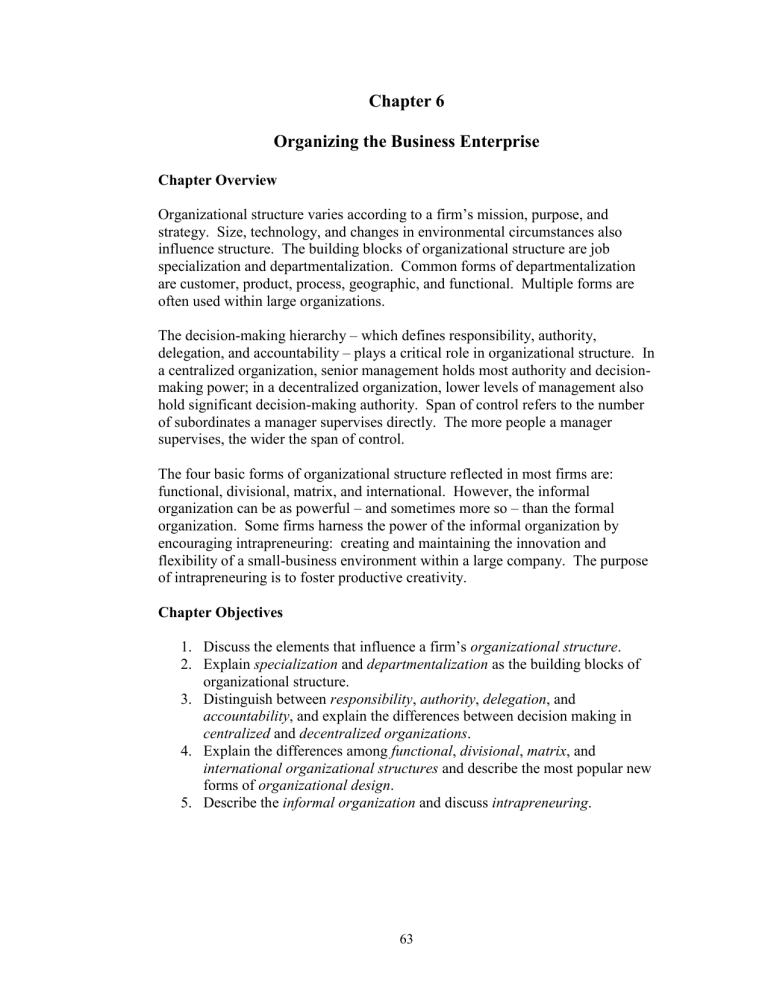
Chapter 6
Organizing the Business Enterprise
Chapter Overview
Organizational structure varies according to a firm’s mission, purpose, and strategy. Size, technology, and changes in environmental circumstances also influence structure. The building blocks of organizational structure are job specialization and departmentalization. Common forms of departmentalization are customer, product, process, geographic, and functional. Multiple forms are often used within large organizations.
The decision-making hierarchy – which defines responsibility, authority, delegation, and accountability – plays a critical role in organizational structure. In a centralized organization, senior management holds most authority and decisionmaking power; in a decentralized organization, lower levels of management also hold significant decision-making authority. Span of control refers to the number of subordinates a manager supervises directly. The more people a manager supervises, the wider the span of control.
The four basic forms of organizational structure reflected in most firms are: functional, divisional, matrix, and international. However, the informal organization can be as powerful – and sometimes more so – than the formal organization. Some firms harness the power of the informal organization by encouraging intrapreneuring: creating and maintaining the innovation and flexibility of a small-business environment within a large company. The purpose of intrapreneuring is to foster productive creativity.
Chapter Objectives
1.
Discuss the elements that influence a firm’s organizational structure .
2.
Explain specialization and departmentalization as the building blocks of organizational structure.
3.
Distinguish between responsibility , authority , delegation , and accountability , and explain the differences between decision making in centralized and decentralized organizations .
4.
Explain the differences among functional , divisional , matrix , and international organizational structures and describe the most popular new forms of organizational design .
5.
Describe the informal organization and discuss intrapreneuring .
63
REFERENCE OUTLINE
Opening Case: Cooking Up a New Structure
I.
What Is Organizational Structure?
A.
Determinants of Organization
B.
Chain of Command
II.
The Building Blocks of Organizational Structure
A.
Specialization
B.
Departmentalization
1.
Customer Departmentalization
2.
Product Departmentalization
3.
Process Departmentalization
4.
Geographic Departmentalization
5.
Functional Departmentalization
III.
Establishing the Decision-Making Hierarchy
A.
Assigning Tasks: Responsibility and Authority
B.
Performing Tasks: Delegation and Accountability
C.
Distributing Authority: Centralization and Decentralization
1.
Centralized Organizations
2.
Decentralized Organizations
3.
Tall and Flat Structures
4.
Span of Control
D.
Three Forms of Authority
1.
Line Authority
2.
Staff Authority
3.
Committee and Team Authority
IV.
Basic Forms of Organizational Structure
A.
Functional Organization
B.
Divisional Organization
C.
Matrix Organization
D.
International Organization
E.
Organizational Design in the Twenty-First Century
1.
Boundary-less Organization
2.
Team Organization
3.
Virtual Organization
4.
Learning Organization
V.
Informal Organization
A.
Formal vs. Informal Organizational Systems
1.
Informal Groups
2.
Organizational Groups
B.
Intrapreneuring
64
LECTURE OUTLINE
I.
What Is Organizational Structure? (Use PowerPoint 6.4.)
Organizational structure defines an organization through specification of the jobs to be performed and the ways in which these jobs relate to one another. All organizations develop their own appropriate structures.
A.
Determinants of Organization (Use PowerPoint 6.5.)
Numerous factors influence the planning and creating of an efficient organizational structure. Managers not only consider the organization’s purpose, mission, and strategy, but also the organization’s size, technology, and environmental changes.
B.
Chain of Command (Use PowerPoint 6.6.)
Organizational charts are prepared to clarify structure and to show employees where they fit into a firm’s operations. The chain of command represents the hierarchy of who reports to whom in the organization.
Notes:
__________________________________________________________________
__________________________________________________________________
__________________________________________________________________
II.
The Building Blocks of Organizational Structure (Use PowerPoint
6.7.)
A.
Specialization
1.
Specialization and Growth. Job specialization , a natural part of an organization’s growth, is the process of identifying the specific jobs that need to be done and designating the people who will perform them. Job specialization may even involve breaking jobs into small components prior to assigning them to individuals.
B.
Departmentalization
Departmentalization is the grouping of similar or related jobs into logical units. Several types of departmentalization exist.
65
1.
Customer Departmentalization. This grouping of jobs simplifies shopping by providing identifiable store segments.
2.
Product Departmentalization. Organizations are divided according to the products or services being produced.
3.
Process Departmentalization.
Organizations are divided according to production processes utilized .
4.
Geographic Departmentalization.
Organizations are divided according to the areas of the country or world that they serve .
5.
Functional Departmentalization.
Organizations are divided according to a group’s functions or activities.
Examples include a firm’s production, marketing, human resource, accounting, and finance departments.
Notes:
__________________________________________________________________
__________________________________________________________________
__________________________________________________________________
III.
Establishing the Decision-Making Hierarchy (Use PowerPoint
6.8.)
The decision-making hierarchy is created by assigning tasks, performing tasks, and distributing authority.
A.
Assigning Tasks: Responsibility and Authority
Responsibility is the duty to perform an assigned task; authority is the power to make decisions.
B.
Performing Tasks: Delegation and Accountability
Delegation begins when responsibility is granted to a subordinate from a supervisor; accountability falls to the subordinate, who must carry out the assigned responsibilities.
C.
Distributing Authority: Centralization and Decentralization
(Use PowerPoint 6.9, 6.10.)
66
1.
Centralized Organizations. In a centralized organization , authority is held by upper-level management.
2.
Decentralized Organizations. In a decentralized organization , authority is delegated to lower levels of management.
3.
Tall and Flat Organizations.
Tall organizations are multi-tiered, characterized by many layers of employees; flat organizations have few layers of employees.
4.
Span of Control. A manager’s span of control is the number of people managed by one supervisor; many factors can lead to a wide or narrow span of control.
D.
Three Forms of Authority (Use PowerPoint 6.11.)
Forms of authority result when individuals are delegated authority and responsibility in a firm. Various forms of authority may be found in any given company.
1.
Line Authority. This authority flows vertically up and down the chain of command.
2.
Staff Authority. This authority is found among departments of advisors and counselors, including specialists such as lawyers, engineers, accountants, and human resource personnel. These individuals aid line departments in making decisions, but do not have the authority to make final decisions.
3.
Committee and Team Authority.
This is the authority that is granted to committees and teams that play central roles in the firm’s daily operations. Employees are typically empowered to plan and organize their own work and to perform that work with minimal supervision.
Notes:
__________________________________________________________________
__________________________________________________________________
__________________________________________________________________
67
IV.
Basic Forms of Organizational Structure (Use PowerPoint 6.12.)
A.
Functional Organization
Often used by most small- and medium-sized firms, functional organizations divide job responsibilities by functional areas, such as marketing or finance.
B.
Divisional Organization
Corporate divisions usually operate under this structure as relatively autonomous businesses under the larger corporate umbrella. Divisions are departments that resemble separate businesses in that they produce and market their own products.
C.
Matrix Organization (Use PowerPoint 6.13.)
In this structure, teams are formed in which individuals report to two or more managers, usually including a line manager and a staff manager. The matrix structure is highly flexible and readily adaptable to changing circumstances.
D.
International Organization (Use PowerPoint 6.14.)
International organizational structures have been developed in response to the need to manufacture, purchase, and sell in global markets.
E.
Organizational Design in the Twenty-First Century (Use
PowerPoint 6.15.)
1.
Boundary-less Organization. In a boundary-less organization , traditional boundaries and structure are minimized or eliminated.
2.
Team Organization. Team organization relies mostly on project-type teams; people float from one project to another as dictated by their skills and the demands of the projects.
3.
Virtual Organization. This organization has little or no formal structure; this organization exists only in response to its own needs.
68
4.
Learning Organization.
The learning organization works to integrate continuous improvement with continuous employee learning and development.
Notes:
__________________________________________________________________
__________________________________________________________________
__________________________________________________________________
V.
Informal Organization (Use PowerPoint 6.16.)
A.
Formal vs. Informal Organizational Systems
A company’s informal organization is comprised of the everyday social interactions between and among employees that transcend formal jobs and job interrelationships.
1.
Informal Groups. Informal organization can be just as powerful as formal organization.
2.
Organizational Grapevine. The organizational grapevine , or the rumor mill, is an informal communication structure in which people communicate through ways that transcend the formal communication processes.
B.
Intrapreneuring
A relatively new concept, intrapreneuring is encouraged among businesses as a way of enhancing creativity and flexibility in large, bureaucratic structures.
69

